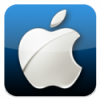
Γλωσσάρι για την Apple, το iPhone, το iPad και γενικότερα
#1

Δημοσίευση 19/01/2011 - 11:26
Achievements: Some iOS games reward you with bonus points with specific achievements (See Game Center)
ActiveSync: Microsoft’s Exchange push mail, calendar, contact, etc. protocol licensed by Apple for Mac OS X and iOS’s Mail app, and by Google for Google Sync.
Ad hoc: A way to distribute apps outside the app store. Limited to 100 UDIDs (devices) per developer account.
AirPlay: Let’s you stream video from iPhone, iPod touch, iPad, or iTunes on a Mac or PC to an Apple TV, and audio to an Airport Express or other compatible speaker system
AirPrint: Let’s you print from any iOS device from an AirPrint compatible printer
Android: Google’s open-source mobile operating system. It’s used primarily in smartphones but also can be found on tablets, Mobile Internet Devices (MIDs) or even in kitchen appliances and automobile navigation. (see AndroidCentral.com)
API: (Application Programming Interface) Part of the iOS SDK provided by Apple to developers that allows them to access official, publicly available functionality in their apps.
App: Short for “application.” The programs you download and run on a smartphone. Can be free, or for sale. Most apps come from Apple’s iTunes App Store but some can be made specifically by and for businesses or schools, and some are made expressly for the Jailbreak Cydia app store.
App Store: Part of iTunes on Windows and Mac and a built-in app on iPhone, iPod touch, and iPad, App Store is the only place to buy 3rd party apps and games for iOS. Introduced in 2008 alongside iOS 2 and iPhone 3G.
Apple: Pioneering personal computer company founded by Steve Jobs and Steve Wozniak, one of the most popular consumer electronics companies, and maker of iPhone, iPod touch, iPad, and Apple TV (among other things).
Apple Store: A retail and online powerhouse that sells, and in the case of retail, services all Apple products including iPhone, iPod touch, and iPad.
Apple TV: Apple’s original, Mac OS X Tiger-based living room set-top box designed to buy media from the iTunes Store or stream it from Mac or Windows iTunes.
Apple TV 2: iOS-based second generation set-top box focused on streaming via Home Sharing or AirPlay, renting from the iTunes Store, and Netflix subscription content.
AT&T: One of the four major U.S. carriers. Formerly the exclusive carrier of Apple’s iPhone in the US, still the only GSM carrier with iPhone in the US and the only carrier providing service for the iPad 3G.
B
Baseband: The Modem Firmware of your iPhone
Blog: (weB LOG) a ongoing internet-based publication, in chronological format, often focusing on a mix of news, commentary, and analysis, with frequent links to other sites on the web. (TiPb is a blog.)
Bluetooth: A short-range radio build into smartphones that lets you connect headsets, speakerphones or even computers to your smartphone.
C
Calendar: One of Apple’s built-in apps, it handles events, invitations, and reminders on iPhone, iPod touch, and iPad.
Camera:: Built-in Apple app that handles the taking of photos and videos on iPhone and iPod touch 4.
Carrier: A company that provides cell phone service.
CDMA: One of two major standard for cell phone communications. Is used by Sprint and Verizon in the United States, and by a few nations elsewhere. Is largely seen as a dying standard. (See also GSM) CES: North America’s largest consumer electronics show, held in January at the Las Vegas Convention Center.
Cocoa Touch: Apple’s iPhone, iPod touch, and iPad Objective-C-based API framework. Used to create iOS apps in Xcode.
Cook, Tim: Chief Operating Officer at Apple. He makes sure things run on time, on budget, all the time. Cook ran Apple during Steve Jobs’ leave of absence.
CSS: (Cascading Style Sheets) are used to style and control the formatting of HTML documents such as web pages.
Cydia: Created by Jay Freeman (Saurik) in March 2008, Cydia is an application for jailbroken iOS devices that allows for the purchase and installation of 3rd party extensions or apps that Apple does not allow in the App Store.
D
DFU Mode: Device Firmware Update mode, most commonly used to exploit and gain access to iOS in order to Jailbreak. Requires holding down the Sleep/Wake button for 3 seconds, then also holding down the Home button for 10 seconds, releasing Sleep/Wake and continuing to hold Home for 5 or more seconds until the screen goes black.
Dock: Special row of icons (or Folders post-iOS 4) along the bottom of iPhone, iPod touch, and iPad that do not change when you swipe between Home Screens.
Dock port: Apple’s proprietary 30-pin interface used to connect iPhone, iPod touch, and iPad to a Mac or Windows PC via USB for syncing, or to connect to a variety of accessories for charging, audio, video, and more.
E
Early Termination Fee: Also known as an ETF, it’s what a carrier chargers you to break out of your contract. Usually are prorated.
F
Facebook: Currently the largest social network on the internet, built on the concept of friend-to-friend connections. One of the few, and the biggest, places on the web Google is excluded from.
FaceTime: Apple’s video calling service. Requires Wi-Fi and is currently only supported via phone number on iPhone and Apple ID email address on iPod touch 4 and Mac (beta).
FairPlay DRM: Apple’s DRM (digital rights management) security, used to protect iTunes movies, TV shows, music videos, apps, and iBooks from piracy. FairPlay can be authorized on up to 5 Windows and Mac machines at one time and a similar number of iOS devices.
Fast App Switcher: Apple’s multitasking dock, hidden behind the regular dock and accessible under iOS 4 and later version by double clicking the Home Button.
Folder: An icon representing a group of apps. Introduced in iOS 4 they are created by dragging on app on top of the other in Jiggly Mode, and deleted by removing all the apps. iPhone and iPod touch can currently hold 12 apps per Folder. iPad can hold 20.
Force Quit: In the Fast App Switcher, tapping and holding an app will put it in Jiggly Mode and tapping the X badge will force it to quit. Built-in apps like Mail and Messages will automatically and immediately restart while 3rd party apps will restart the next time you launch them.
Forstall, Scott: Senior Vice President of iOS software, came to Apple from NeXT with Steve Jobs. He’s in charge of everything that makes your iPhone, iPod touch, iPad, and Apple TV run.
G
Game Center: Apple’s gaming portal where you can discover new games and share your game experiences with friends from around the globe
Genius Bar: A counter located in Apple Retail Stores where Mac, iPhone, iPod, and iPad users can make appointments and get service for their products.
Gmail: Google’s web-based e-mail service. Can be set up as an Exchange account on iPhone, iPod touch, and iPad
Google: The biggest company on the net and the provider of the maps data, YouTube videos, and Gmail for iOS users.
GSM: One of two major standard for cell phone communications. Is used by AT&T and T-Mobile in the United States, and by the majority of carriers worldwide. (See also CDMA)
H
Hack (Hacking): Modifying a Jailbroken iOS device in order to change or enhance functionality.
Home Button: The physical hardware button on the front of the iPhone, iPod touch, and iPad, beneath the screen. Used to wake, return to the Home Screen, cycle between the Home Screen and Spotlight Search screen, open the Fast App Switcher, and optionally enabled Accessibility features.
Home Screen: The front end of Apple’s Springboard app launcher that consists of 11 screens that hold app icons, Folders, the Dock, the Fast App Switcher, and the Spotlight Search screen.
HTML: (HyperText Markup Language) is a standard for structuring text, images, and other content for display in web browsers such as iOS Safari. Tags are used to mark the beginning and end of elements that are then either styled by CSS or turned into actions like web links.
I
iBooks: Apple’s eBook reader, available from the App Store. It handles the standard ePub format protected by FairPlay DRM, and PDF. Introduced in 2010 alongside the iPad.
iBookstore: iTunes for iBooks, it allows you to browse, search, and buy iBook format eBooks.
iPad: Apple’s first tablet device, announced in January 2010 and released in April of the same year. It runs a modified version of iOS optimized for its larger, 9.7? screen.
iOS: Apple mobile operating system and the software that powers the iPhone, iPod touch, iPad, and Apple TV.
iOS SDK: Apple’s official Software Development Kit for iPhone, iPod touch, and iPad containing Cocoa Touch frameworks, APIs, development tools, and other elements necessary to create iOS apps.
iOS 2: Originally called iPhone 2.0 it was announced at the first ever Apple Preview Event in 2008 and was released alongside iPhone 3G on June 29 of the same year. Major new features included an SDK for developers, and App Store for 3rd party apps, and support for Apple’s MobileMe service.
iOS 3: Originally called iPhone 3.0 it was announced at the second Apple Preview Event in 2009 and released prior to the iPhone 3GS on June 17 of the same year. Major new features included copy/paste, MMS, and tethering (unsupported by AT&T).
iOS 4: Announced at the third Apple Preview Event in 2010 and released prior to iPhone 4 on June 21 of the same year. Major new features included multitasking, folders, and FaceTime video calling.
iPhone 2G: Original iPhone announced at Macworld 2007 and released June 29 of the same year. Major innovations included the multitouch user interface.
iPhone 3G: Second iPhone announced at WWDC 2008 and released July 11 of the same year. Major new features included a 3G radio and an all new design.
iPhone 3GS: Third iPhone announced at WWDC 2009 and released June 19 of the same year. Major new features included faster processors and video recording.
iPhone 4: Forth iPhone announced at WWDC 2010 and released June 24 of the same year. Major new features included an A4 processor, Retina Display, front facing camera, and an all new design.
iPod touch G1: Apple’s first generation multitouch, full screen, internet enabled iPod released September 5, 2007.
iPod touch G2: Apple’s second generation iPod touch, it added volume buttons and a built-in speaker. Released September 9, 2008.
iPod touch G3: Apple’s third generation iPod touch, it added more RAM and faster CPU and GPU. Released September 9, 2009.
iPod touch G4: Apple’s fourth generation iPod touch, it added a Retina Display, front and back facing cameras with FaceTime, and a gyroscope.
iTunes: Mac and Windows software used to activate and sync iPhone, iPod touch, and iPad. Also used to manage music, movies, TV shows, apps, books, and other media, and access the Ping social music network. Currently on version 10, released September 2010.
iTunes App: iPhone, iPod touch, and iPad app used on-device to access the iTunes Store and Ping social network.
iTunes Connect: Apple’s developer portal. Used to submit apps for review by Apple, and to manage them by developers, including setting price and availability.
iTunes Store: Online store run by Apple for purchasing music, movies, TV shows, and apps, and downloading podcasts and other media. Accessible via iTunes on Mac or Windows or the iTunes app on iPhone, iPod touch, or iPad.
J
Jailbreak: Breaking open the root jail Apple uses to secure iOS, allowing a user to customize the device and install apps outside of the App Store. Also required for AT&T carrier unlock.
JavaScript: Scripting language, not at all related to Java, used by web pages to program enhanced functionality and interactivity.
Jiggly Mode: Tap and hold an app and it will begin to “jiggle”, indicating you can move them around the Home Screen, from screen to screen, put them into folders, delete them by tapping their X badge (App Store apps only), or Force Quit them if they’re in the Fast App Switcher.
Jobs, Steve: Co-founder and CEO of Apple and product visionary behind iPod, iTunes, iPhone, iPad, etc.
K
Kernel: The basic Unix building block of iOS. Like Apple’s Mac, iOS devices are based on the BSD-derived Darwin kernel.
KHTML: The original Linux browser technology WebKit, and hence Apple’s Safari comes from.
L
LDAP: (Lightweight Directory Access Protocol) can view and search contacts on your company or organization’s LDAP server
M
Mail: Built-in Apple app for handling POP3, IMAP, MobileMe, and Exchange/ActiveSync email accounts.
Messages: One of Apple’s built-in iPhone apps that handles SMS text messages and MMS multimedia messages.
MMS: (MultimediaMmessages), introduced in iOS 3 and support images, videos, sound, contact cards, and location. Sent and received via the Messages app on iPhone to other mobile/cell phones.
MobileMe: Apple’s push mail, calendar, and contacts service for iOS. Also includes galleries, iDisk, and Mac-only services like Back to my Mac, Mac Sync, and iWeb pages.
N
NeXT: Company founded by Steve Jobs after he was ejected from Apple. Ultimately purchased by Apple, prefacing the return of Jobs. NeXT technology, like NeXTStep evolved into the foundations of Mac OS X and iOS.
NeXTSTEP: Objective-C programming framework purchased by Apple as part of the NeXT acquisition and evolved into Cocoa on Mac OS X and Cocoa Touch on iOS.
Nitro: Apple’s JavaScript rendering engine used in the WebKit-based Safari browser for Mac, Windows, and iOS.
O
Objective-C: Apple’s superset of the C programming language used as part of the Cocoa Touch APIs to create iPhone, iPod touch, and iPad apps. Derived from NeXT’s NeXTSTEP.
Open GL: An open source 3D graphics library used in many devices, including iOS devices Open Source: Software which is liberally licensed to grant the right of users to study, change, and improve its design through the availability of its source code.
OTA: (Over the Air) The act of moving data to your phone — downloading, really — without having to plug it in. iOS devices can buy music, download apps, sync data, etc. OTA.
P
Photos: Built-in Apple app that handles the camera roll for iPhone and iPod touch 4, and synced photos and videos for iPhone and all generations of iPad and iPod touch.
Ping: Apple’s social music network launched in September 2010 alongside the fourth generation iPod touch. It lives inside iTunes on Mac, Windows, and iOS and is hooked into Twitter.
Private API: An API that may or may not be used by Apple but isn’t finished, polished, or otherwise approved for developers to use in App Store apps. Apple will reject any app that uses a Private API.
Public API: An API approved by Apple and made available in the iOS SDK. Public API’s are a guarantee by Apple that developers can use them and not worry Apple will make changes, which could result in apps crashing or having experiencing other bugs.
Q
QuickTime: Apple’s 2D graphics layer, used to play movies and other video on iOS.
R
Respring: Relaunching iPhone, iPod touch, or iPad’s Springboard. Typically used by Jailbreak apps after installation or changes to Springboard.
Retina Display: 960×640, 326ppi display available on iPhone 4 and iPod touch 4.
S
Safari: Apple’s web browser, both for Mac OS X and iOS (sometimes called Mobile Safari). Based on KHTML/WebKit renderer and the Nitro JavaScript engine.
Schiller, Phil: Senior Vice President of Marketing at Apple. When Steve Jobs was on leave of absence, Schiller stepped in to the Keynote hot seat.
SDK: (Software Developers Kit) a set of tools, including API, frameworks, interface elements, etc. used to create software, i.e. apps.
SHSH Blobs: (Signature HaSH) is a 128-byte digital signature generated by Apple and used to verify firmware on iPhone, iPod touch, and iPad. Since Apple will not verify older firmware, SHSH blobs are typically saved to Cydia or services like Tiny Umbrella by Jailbreakers so they can rollback to older firmware.
SIM card: The little card used in GSM phones (AT&T, Rogers, O2, etc.) that connects the phone to the network.
Sleep/Wake Button: Physical hardware button on top of the iPhone, iPod touch, and iPad. Used to power on, wake from sleep, put to sleep, and power down iOS devices.
SMS: (Short Message Service) Text messages sent from the Messages app on iPhone to other cell/mobile phones.
Spotlight Search: Part of the iPhone, iPod touch, and iPad Home Screen system, accessible by swiping left to right or clicking the Home Button when on the primary Home Screen, or inside Apple apps like Messages, Mail, Contacts, iPod, etc. Performs text-based search and shows results for contacts, apps, music, podcasts, videos, audiobooks, notes, mail, calendar events, and SMS messages.
Springboard: The internal name of the program Apple uses to run the iOS home screen, including the app launcher and fast app switcher.
Sprint: One of the four major U.S. carriers.
SSH: (Secure SHell) is a secure network communication protocol used to communicate between Mac or Windows and a Jailbroken iOS device. Apple defaults all iPhone, iPod touch, and iPad SSH passwords to “alpine”, which should be changed for security reasons if SSH is enabled.
T
T-Mobile: One of the four major U.S. carriers.
Tethering: The act of using your iPhone’s data to provide Internet access to another device, such as a laptop. Can be done via Bluetooth or via a USB cable.
Twitter: One of the most popular social networks built around a follower/following system rather than friends, and limited to 140 characters (think micro-blog meets SMS).
U
UDID: (Unique Device Identifier) The series of numbers and letters used by Apple and developers to uniquely identify your iPhone, iPod touch, and iPad. Your UDID needs to be registered with Apple’s developer program to run beta versions of iOS and needs to be included in developer’s provisioning files to run Ad Hoc apps.
USB: Stands for Universal Serial Bus. Is a method of connecting devices to a computer. Apple iOS devices connect via dock port to your computer’s USB port.
V
Verizon: One of the four major U.S. carriers. Currently the only CDMA carrier in the US to offer the iPhone 4. Also currently offers the iPad + MiFi combo.
VPN: (Virtual Private Network) provides secure access over the Internet to private networks, such as the network at your company or school.
W
WebKit: Apple supported open source HTML browser rendering engine that forms the foundation of Safari on Mac, Windows, and iOS. Also used by Google’s Chrome, Palm webOS, Nokia, and others.
Wi-Fi: A trademark of the Wi-Fi Alliance, commonly used to refer to 802.11g (pre-2010 iOS devices) or 802.11n (post-2010 iOS devices) wireless networking.
X
Xcode: Apple’s IDE (Integrated Development Environment) used to write Objective C code and create native App Store apps.
Y
YouTube: Google’s web-based streaming video service. Accessible from iPhone or iPod touch via the YouTube app, or iPad either inline or via the YouTube app.
YouTube app: One of Apple’s built-in iOS apps that allows searching, browsing, and playback of H.264 format YouTube videos.
Z
[via]
Ad
#2

Δημοσίευση 19/01/2011 - 11:28
#3

Δημοσίευση 19/01/2011 - 11:29
Αν μεταφραστει, θα πιασει τοπο..Θα πιάσει τόπο! Thnx
#4

Δημοσίευση 19/01/2011 - 11:32
Αν μεταφραστει, θα πιασει τοπο..
Φιλε μου ειναι γραμμενο σε απλα Αγγλικα. Νομιζω ολοι μπορουν να το καταλαβουν. Δυστυχως δεν εχω χρονο για να μεταφρασω ολο το κειμενο και ισως με τη μεταφραση να χαθουν καποιες εννοιες οι οποιες βγαζουν νοημα μονο στα Αγγλικα. Ουτε και η λυση ειναι να το βαλω στο translate του Google.
#5

Δημοσίευση 19/01/2011 - 11:33

#6

Δημοσίευση 19/01/2011 - 11:35

#7

Δημοσίευση 19/01/2011 - 11:36
Φιλε μου ειναι γραμμενο σε απλα Αγγλικα. Νομιζω ολοι μπορουν να το καταλαβουν. Δυστυχως δεν εχω χρονο για να μεταφρασω ολο το κειμενο και ισως με τη μεταφραση να χαθουν καποιες εννοιες οι οποιες βγαζουν νοημα μονο στα Αγγλικα. Ουτε και η λυση ειναι να το βαλω στο translate του Google.
Συμφωνώ με τον προλαλλήσαντα, τα συγκεκριμένα αγγλικά είναι όντως απλά! Καλά κάνεις και δεν το βάζεις στο translate διότι είναι επιεικώς άθλιο!!!
Χρήστες που διαβάζουν αυτό το θέμα: 1
0 μέλη, 1 επισκέπτες, 0 ανώνυμοι χρήστες











